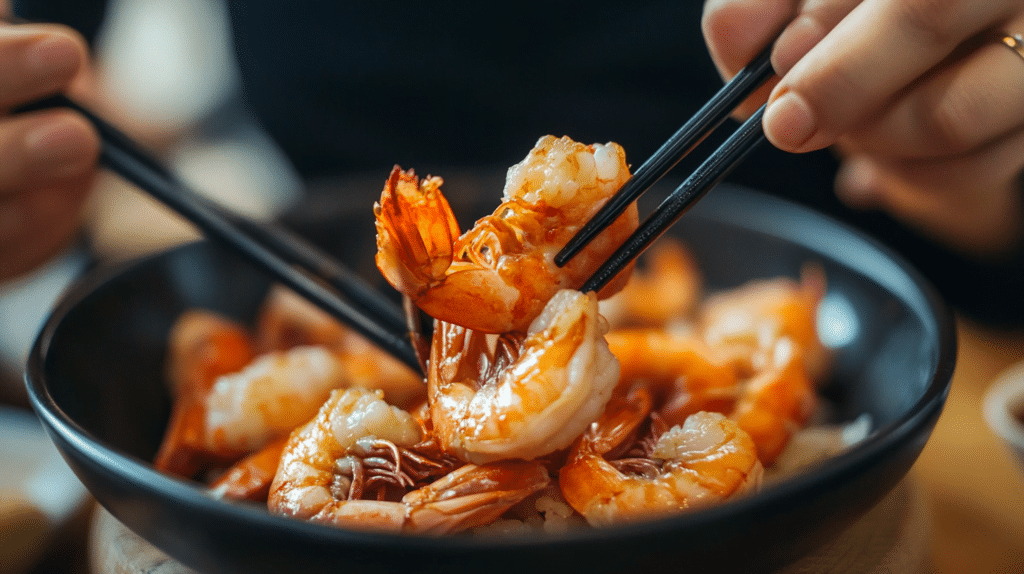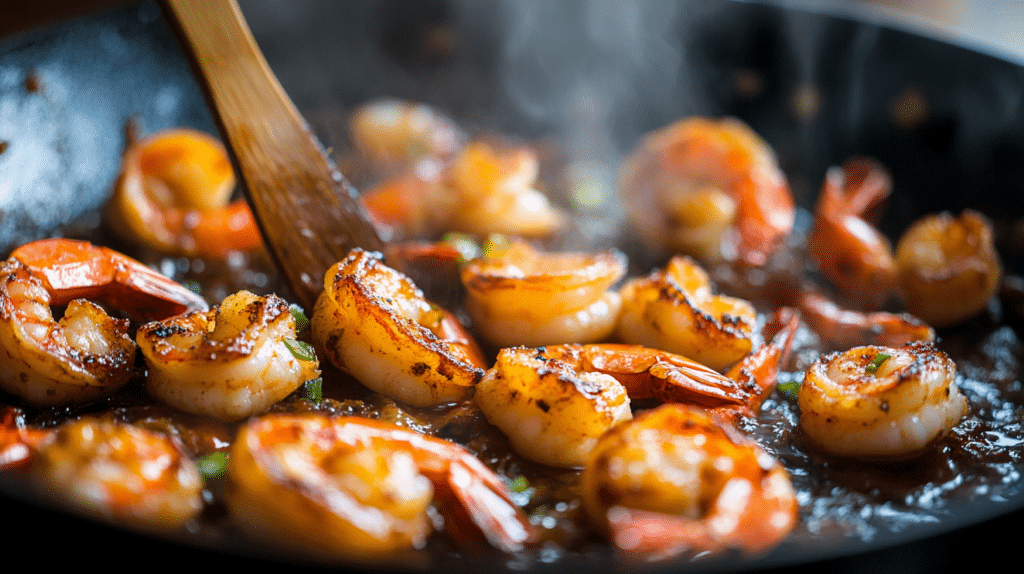Shrimp lovers often wonder about those crunchy tails left on their plates. Are they just for show, or can you eat them?
Experts agree that these often-discarded parts are not only edible but can also offer nutritional benefits when consumed properly.
This article promises to delve into expert opinions on consuming shrimp tails, providing a comprehensive understanding of their nutritional value and practical tips on their safe consumption.
We’ll explore insights from dietitians and health professionals to help you make an informed decision.
By the end of this post, you’ll have a clear picture of whether incorporating shrimp tails into your diet is right for you.
Can You Eat Shrimp Tails?
The simple answer is yes, shrimp tails are indeed edible. They’re not harmful or toxic to consume, and in fact, they offer some nutritional benefits.
In many Asian cultures, eating shrimp tails is a common practice. You’ll often find dishes like shrimp tempura where the tails are left on, adding extra texture and flavor to the meal.
In these cuisines, shrimp tails are considered a delicacy, prized for their satisfying crunch and the depth of flavor they bring to dishes.
However, whether to eat shrimp tails often comes down to personal preference.
Some people enjoy the additional texture and crunch they provide. Others might find the mouthfeel less appealing or prefer to avoid them due to their tougher texture.
Remember, there’s no right or wrong way to eat shrimp. It’s all about what you enjoy and what feels right for your palate.
Nutritional Content in Shrimp Tails
| Nutrient | Amount per 100g | |
|---|---|---|
| Calories | 106 kcal | |
| Protein | 20.3g | |
| Fat | 1.7g | |
| Dietary Fiber (Chitin) | Not fully digestible | |
| Calcium | 40mg | |
| Zinc | 1.34mg | |
| Astaxanthin (Antioxidant) | Varies | |
| Magnesium | 30mg | |
| Omega-3 Fatty Acids | Trace amounts | |
| Phosphorus | 200mg |
Please Note:
- These values are approximate and can vary based on factors like shrimp species and preparation methods.
- Chitin, while present, is not fully digestible by humans but acts as dietary fiber.
- Astaxanthin content can vary significantly and is often not quantified in standard nutritional analyses.
- This table focuses on the most significant nutrients found in shrimp tails.
These nutrients make shrimp tails a surprisingly nutritious addition to your meals, offering benefits beyond flavor and texture.
Experts’ Opinion on Eating Shrimp Tails

- Many dietitians highlight the high protein content of shrimp tails. A typical 3-ounce serving of shrimp provides about 20 grams of protein, making it an excellent source of this essential nutrient.
Protein is crucial for muscle repair, growth, and overall bodily functions. Dietitians often recommend shrimp tails as a lean protein option for those looking to maintain or increase their protein intake.
- Experts also highlight the low saturated fat content in shrimp tails, which makes them a heart-healthy choice for many individuals.
Consuming foods low in saturated fat is beneficial for maintaining healthy cholesterol levels, which is crucial for cardiovascular health.
- Experts note that these nutritional benefits make shrimp tails a smart choice for those looking to increase their protein intake while keeping their saturated fat consumption in check.
While praising the nutritional benefits, dietitians also advise moderation for certain groups.
- They note that although shrimp is high in cholesterol, dietary cholesterol doesn’t significantly impact blood cholesterol levels for most people.
However, individuals with high cholesterol or specific heart conditions are often advised to consume shrimp tails in moderation.
- Health professionals strongly emphasize the importance of being aware of shellfish allergies. Shellfish allergies are among the most common food allergies and can be severe, even life-threatening.
They advise that individuals with known shellfish allergies should avoid shrimp tails entirely due to the risk of severe allergic reactions.
Overall, dietitians view shrimp tails as a nutritious food option when consumed as part of a balanced diet while stressing the importance of individual health considerations and moderation.
Practical Tips for Safe Consumption

Proper Preparation
1. Cleaning
Experts emphasize the importance of thorough cleaning when preparing shrimp tails.
Start by rinsing shrimp under cold running water, using a small brush to clean the shells. This prevents contamination and enhances taste.
Next, remove the vein along the back of the shrimp using a sharp knife or deveining tool. This will eliminate residual sand and reduce the risk of digestive discomfort.
You ensure a safer and more enjoyable eating experience by carefully following these cleaning steps.
2. Cooking
For cooking, several methods are recommended to enhance flavor and ensure safe consumption:
- Grilling: Marinate shrimp and cook over medium-high heat until slightly charred, enhancing natural flavors with a smoky taste.
- Sauteing: Use a hot pan with oil or butter for a quick, crispy result that retains tenderness while adding rich flavor.
- Roasting: Cook shrimp in a hot oven to bring out natural flavors and ensure even crispiness, contrasting the texture between tender meat and crispy tails.
By following these preparation and cooking techniques, you can safely enjoy the nutritional benefits of shrimp tails while maximizing their flavor potential.
Portion Control
1. Moderation
Moderation is key when introducing shrimp tails to your meals. Start with small portions to gauge your body’s reaction, and gradually increase the serving size as you become accustomed to the texture and taste.
It’s crucial to monitor your health closely, paying attention to any signs of allergic reactions or digestive discomfort.
If you experience any adverse effects, reduce the portion size or consult a healthcare professional for guidance.
2. Balanced Diet
Incorporating shrimp tails into a balanced diet is equally important. Ensure that your meals include a variety of protein sources, vegetables, and whole grains alongside shrimp tails.
This diverse approach helps maintain overall nutritional balance. Pair shrimp tails with nutrient-dense ingredients such as leafy greens, whole grains, and healthy fats to maximize the health benefits.
This combination provides a broad spectrum of essential nutrients, contributing to overall health and well-being.
By following these portion control and balanced diet strategies, you can safely enjoy the nutritional benefits of shrimp tails while minimizing potential risks and ensuring a well-rounded diet.
Conclusion
Expert opinions on consuming shrimp tails reveal both nutritional benefits and safe consumption.
While they offer valuable protein, minerals, and antioxidants, concerns exist for those with shellfish allergies or certain health conditions. The key lies in informed consumption and moderation.
For those who can safely enjoy shrimp tails, they can be a flavorful and nutritious addition to a balanced diet. However, proper preparation and portion control are crucial.
Ultimately, eating shrimp tails should be based on individual health considerations. If you’re unsure, consult with a healthcare professional or nutritionist.
So, what’s next? Why not try incorporating shrimp tails into your next meal? Remember to start with small portions and consider how your body responds.
Share your experiences or favorite shrimp tail recipes in the comments below!
Frequently Asked Questions
Are Shrimp Tails Safe to Eat?
Yes, shrimp tails are generally safe to eat for most people.
Are Shrimp Tails Nutritious?
Shrimp tails are nutritious, providing protein, dietary fiber (chitin), calcium, zinc, magnesium, phosphorus, and antioxidants like astaxanthin.
Can Shrimp Tails Cause Allergic Reactions?
Yes, individuals with shellfish allergies should avoid shrimp tails as they can trigger severe allergic reactions, including anaphylaxis.
Do Shrimp Tails Contain Cholesterol?
Yes, shrimp tails are relatively high in cholesterol.
What Should I Do if I Experience an Adverse Reaction After Eating Shrimp Tails?
If you experience an adverse reaction, such as an allergic response or digestive discomfort, reduce the portion size or consult a healthcare professional for guidance.




